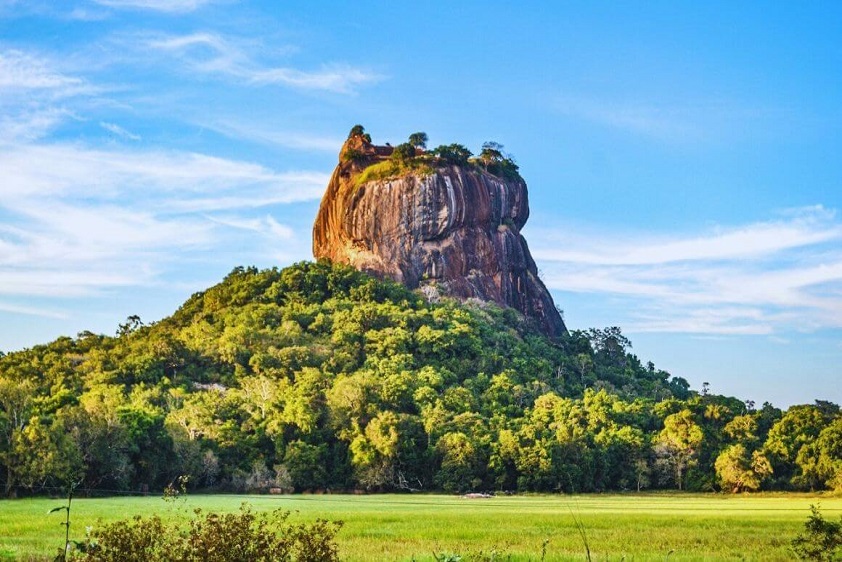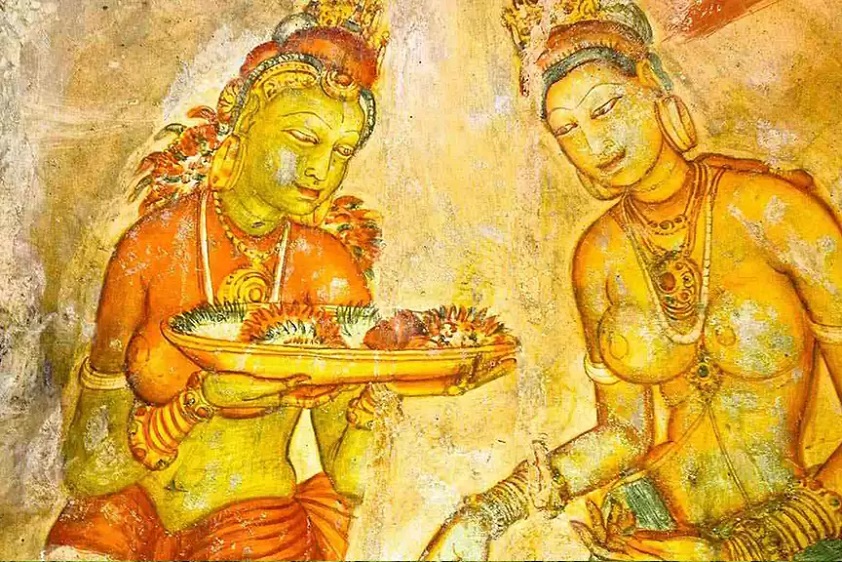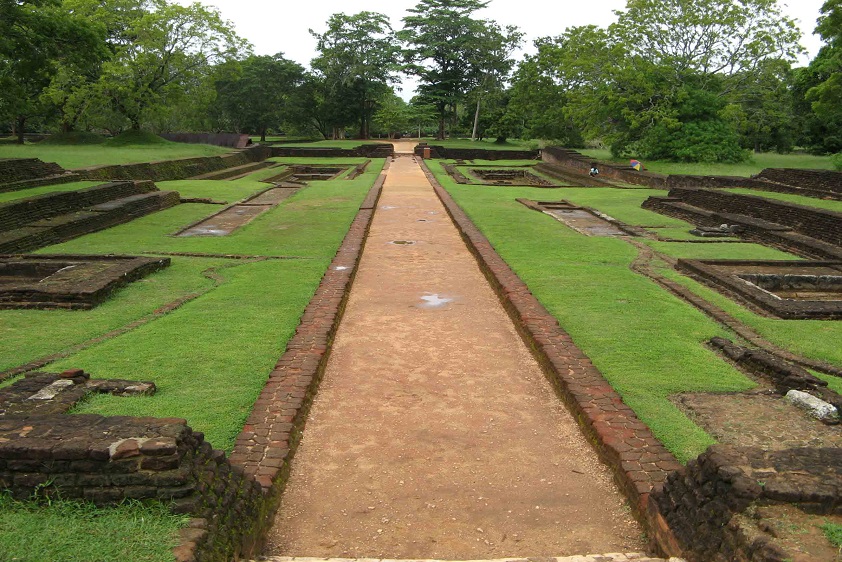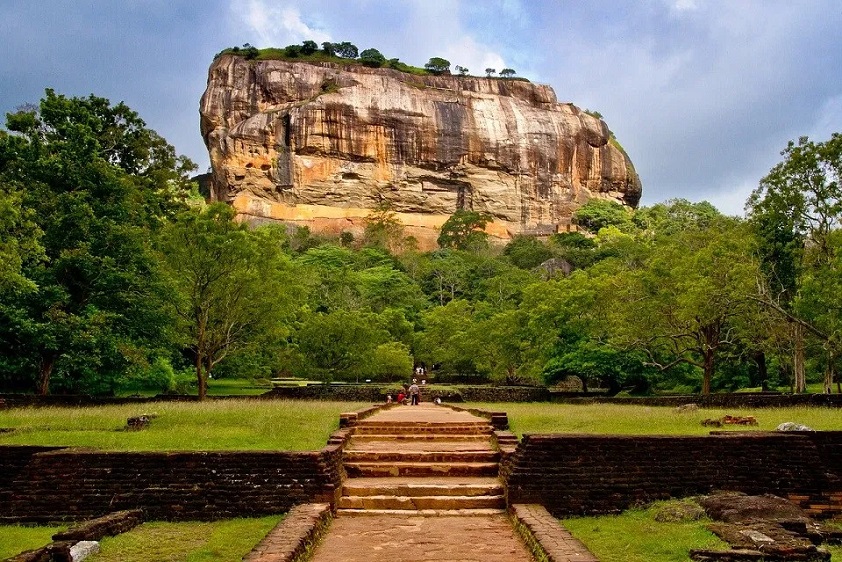Sigiriya is an ancient rock fortress and palace built by King Kashyapa during the reign of 473 – 495 which is standing majestically 660 feet straight up. It is located in the northern Matale district near the town of Dambulla in central province of Sri Lanka. The word Sigiriya or the Sinhagiri means the Lion’s Rock where you have to climb up 1200 steps before you reach the Lion Rock Fortress on top of Sigiriya. There are several platforms that break up the steps and allow for a little break if you need it. Today Sigiriya rock fortress is one of the most famous Archeological Treasure and UNESCO named Sigiriya rock as a World Heritage in 1982 under the name “Ancient City of Sigiriya Sri Lanka”.
The Sigiriya site contains the ruins of an upper palace located on the flat top of the rock, a mid-level terrace that includes the Lion Gate and the mirror wall with its frescoes, the lower palaces clings to the slopes below the rocks.

Sigiriya Rock History
The Sinhalese king Kashyapa I (reigned 477–495) built a palace in the shape of a monumental lion on the several acres of ground at the summit, intending it to be a safeguard against his enemies. However, the king was defeated in 495, and the palace fell into ruin. The site soon became a pilgrimage destination, however, and it is now a popular tourist spot. Visitors begin the final ascent to the top through the open paws of the lion, one of the few remaining portions of the palace that are still intact. Also notable are 21 rock paintings of apsaras (celestial singers and dancers). Sigiriya was designated a UNESCO World Heritage site in 1982.

Buddhist monastic settlements were established during the 3rd century BC in the western and northern slopes of the boulder-strewn hills surrounding the Sigiriya rock. Several rock shelters or caves were created during this period. These shelters were made under large boulders, with carved drip ledges around the cave mouths. Rock inscriptions are carved near the drip ledges on many of the shelters, recording the donation of the shelters to the Buddhist monastic order as residences. These were made in the period between the 3rd century BCE and the 1st century AD.
How to Reach?
From Colombo to Sigiriya Rock 174km Far away. You can choose easy way to reach Sigiriya Rock.
What You Can Do Here?
If you visit in Sigiriya Rock, there are lots of things to do for your enjoying. You can watch sigiriya walla art , gardens, watch ruins, get knowledge about sigiriya history, sightseeing, take photos & many more.
Here is a long list of major things to do in Sigiriya Rock. Which the first time travelers can visit and experience.
Sigiriya Rock Steps
You will have to climb about 1,200 steps before you reach the very top of the Lion Rock. Don’t imagine one continuous staircase, but rather a succession of little platforms, walkways, and stairs. Some of them are hewn into the rough rock; others will remind you of fire escape stairs. So, it’s quite a mixed affair.

Watch Sigiriya Frescoes
The Sigiriya Frescoes were painted on the western surface of Sigiriya Rock, located in central Sri Lanka. This artwork was the highlight of a massive palace complex built in 480AD by King Kasyapa. Today only a few of these murals survive, in a small pocket about 100 meters above ground.
Walk around Ancient gardens of Sigiriya
There are along with the citadels most notable attractions are its three royal gardens: the water gardens, the boulder gardens, and the terraced gardens.

01. Water Garden
As you step in through Sigiriya’s main entrance, you’ll notice the water gardens extending to the base of the rock. The first of the gardens comprises bathing pools that may tempt you to take a dip (but we’d advise you not to!). This garden was built in line with an ancient gardening layout known as ‘Charbagh’.
02. The Boulder Gardens
The boulder gardens are situated closer to the rock, and were once the foundation for the monasteries that were part of Sigiriya prior to King Kasyapa’s takeover. Numerous large boulders sit heavily along the garden, with winding routes taking you through the ruins.
03. The Terraced Gardens
Finally, we have the terraced gardens, which are actually a part of the hill that leads to the fortress. The terraces lead from the pathways of the boulder garden to the citadel’s staircases, and don’t, by definition, represent a ‘garden’, but it’s a beautiful sight regardless, with the limestone pathways bordering it.
Sightseeing
Here you can ruins & get more information about Sigiriya & Fortress.
Take Photos
You can take lots of pictures sigiriya & sigiriya surroundings. There are beautiful areas. You can take variety location photos.


